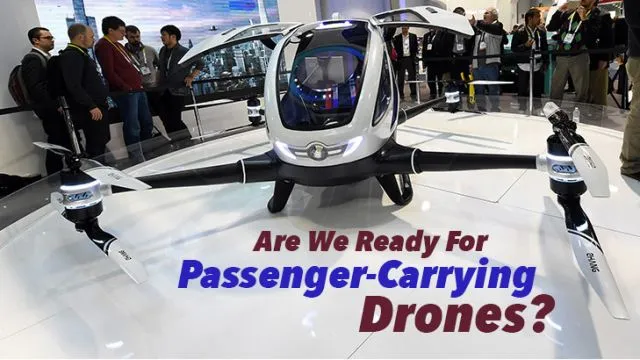
- Share on Facebook34
- Share on Pinterest
- Share on Twitter
Originally used for military and commercial purposes, drones have been kept mostly from the public eye, other than small hobbyist models. Now, the first passenger-carrying drone could soon hit the skies.
Developed in China – tested in the US
The future is fast approaching as Nevada gets ready to allow test flights of the first autonomous passenger-carrying drone. The EHang 184 is about four feet tall, weighs 440 lbs. and has eight propellers, according to the Las Vegas Review Journal. Developed in 2013 by the Chinese company EHang, it could be the first personal drone mini-copter to take flight. The low-altitude vehicle can carry one passenger for 23 minutes at 60 mph, certainly enough to get to work if your commute is less than 20 miles or so.
Dubbed as safe, smart and eco-friendly, the autonomous drone will provide medium- to short-distance travel for about $200,000. To fly the drone, a passenger enters a destination on a 12-inch touch screen in front of their seat. The drone’s on-board computer then works out the best route. There is no passenger override function, which means a rider could not take control in an emergency. If the drone were to malfunction, it would instead land in the nearest available area.
The future in commercial drones
Last year, the U.S. Federal Aviation Administration (FAA) granted retail giant Amazon permission to begin testing drones. Dubbed Prime Air, the delivery system is designed to get packages to customers in 30 minutes or less using small, unmanned drones. But Amazon isn’t the only tech giant jumping on drone technology.
Last year, Facebook unveiled its Aquila solar-powered drone for Internet access. The solar-powered drone flies without landing for three months at a time, using a laser to beam data to a base station on the ground and provide Internet access to remote areas. The mission is to connect everyone to the world to the web. The Facebook drone has the wingspan of a Boeing 737 and was scheduled for testing last year.
A similar drone developed by Google crashed during a test run in New Mexico last year. However, Google also is working on a delivery service, known as Project Wing, that competes with Amazon’s Prime Air.
Meanwhile, Google Founder Larry Page reportedly is working on a flying car. In a world of self-driving cars, Uber and bullet trains, a personal drone suddenly seems pedestrian.
Where to park this thing?
Understandably, regulation of commercial drones has proved tricky in both the United States and Europe. Actual passenger drones might not take flight. Experts also are weighing in over whether autonomous passenger-carrying drones would have mass appeal.
While the idea of hopping into your mini-copter and zipping skyward has loads of appeal (and no designated driver required) in the end, it really comes down to safety, cost, size and the distance one is able to travel. One would need to be in place for landing, parking and storage, too. Where would you put your personal drone-copter once you’ve landed at your parents’ condo?
Nevertheless, once a technology is proven, the rest inevitably fall into place. Now where are the jet boots we were promised?
—Katherine Marko
- Share on Facebook34
- Share on Pinterest
- Share on Twitter

